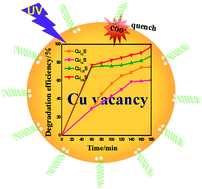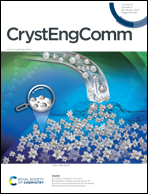Cu-Deficient plasmonic Cu2−xS nanocrystals induced tunable photocatalytic activities†
Abstract
Copper sulfide (Cu2−xS) is a kind of cation deficient transition metal sulfide, which has attracted great interest due to its unique properties that arise from degenerate vacancy-doping, particularly its tunable localized surface plasmon resonance (LSPR) properties. In this work, a range of vacancy-doped Cu2−xS nanocrystals (NCs) (Cu1.2S, Cu1.4S, Cu1.75S, and Cu1.94S NCs) with a size of around 10 nm was prepared with tunable LSPR through a hot injection method. The doping level was manipulated effectively by varying the injection volume of sulfur powder–oleic acid (S–OA) to finely tune the LSPR wavelength. Cu2−xS NCs with four different doping levels were investigated as photocatalysts for degradation of dyes. The Cu1.94S NCs with the highest LSPR energy exhibited the best photocatalytic activity due to the highest free carrier density, presumably influenced by Cu vacancies and the volume of the S–OA solution. Theoretical calculations of the free carrier density of Cu2−xS NCs are consistent with the order of the photocatalytic activity. The results demonstrate that the correlation of the photocatalytic activity with the corresponding concentration of free holes and the LSPR wavelength is of interest, which will provide inspiration for the design of non-noble metal catalysts by regulating the free hole concentration in degenerate p-doped Cu2−xS caused by cation vacancies.

- This article is part of the themed collection: Editor’s Collection: Imperfect nanocrystals for Perfect Catalysis


 Please wait while we load your content...
Please wait while we load your content...